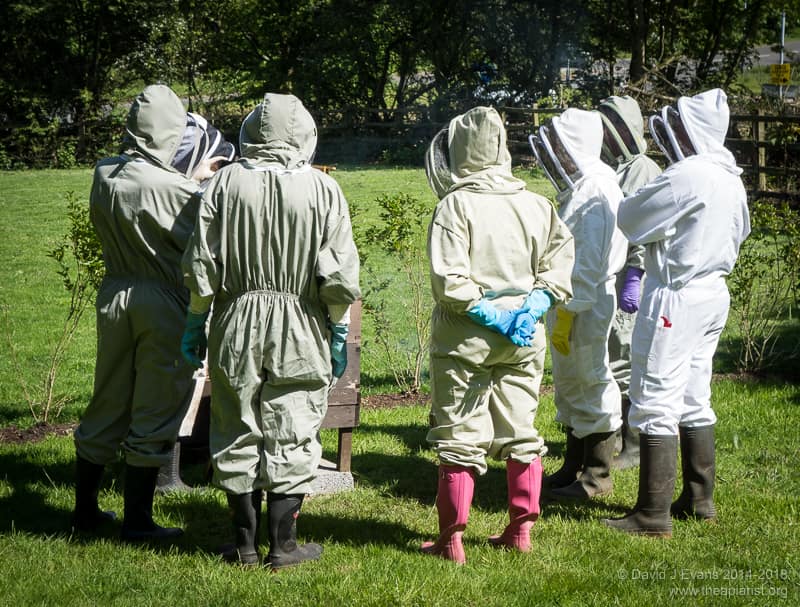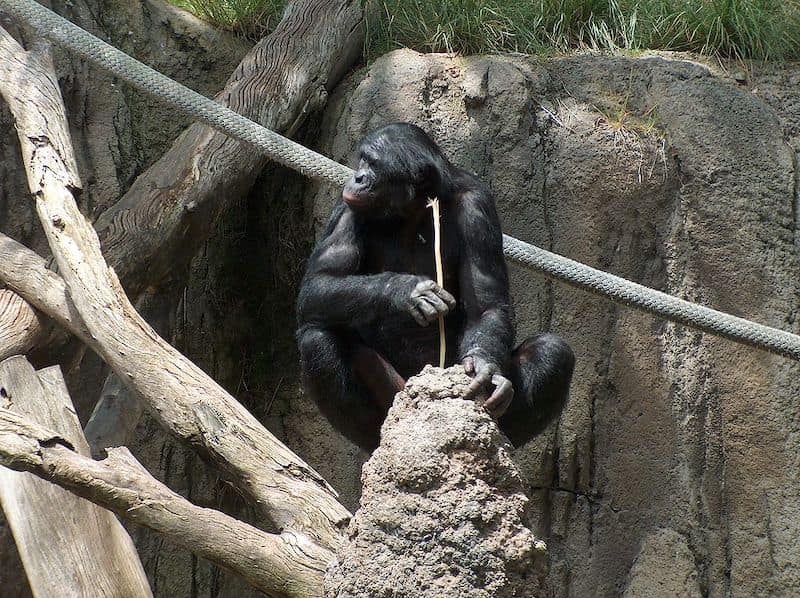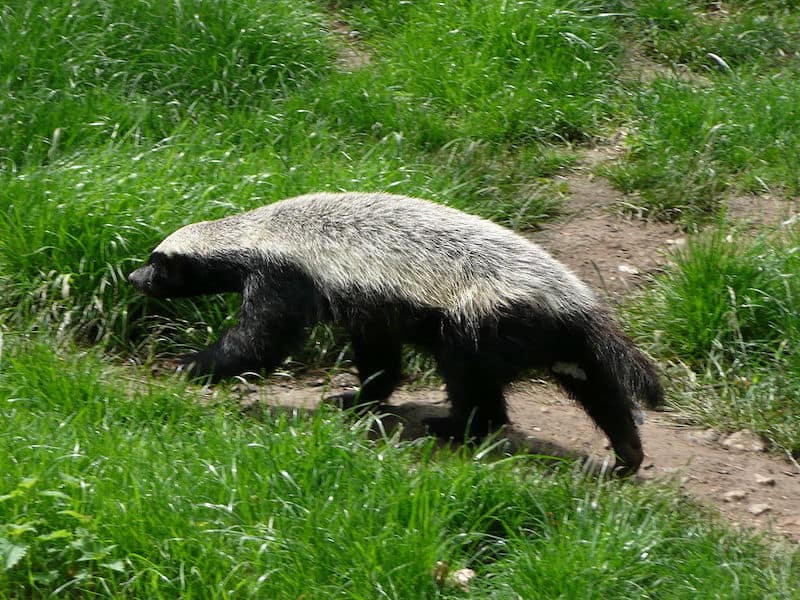Smell the fear
With Halloween just around the corner it seemed appropriate to have a fear-themed post.
How do frightened – or even apprehensive – people respond to bees?
And how do bees respond to them?
Melissophobia is the fear of bees. Like the synonym apiphobia, the word is not in the dictionary {{1}} but is a straightforward compounding of the Greek ??????? or Latin apis (both meaning honey bee) and phobos for fear.
Melissophobia is a real psychiatric diagnosis. Although people who start beekeeping are probably not melissophobic, they are often very apprehensive when they first open a colony.
If things go well this apprehension disappears, immediately or over time as their experience increases.
If things go badly they might develop melissophobia and stop beekeeping altogether.
Even relatively experienced beekeepers may be apprehensive when inspecting a very defensive colony. As I have discussed elsewhere, there are certain times during the season when colonies can become defensive. These include when queenless, during lousy weather or when a strong nectar flow ends.
In addition, some colonies are naturally more defensive than others.
Some could even be considered aggressive, making unprovoked attacks as you approach the hive.
A defensive response is understandable if the colony is being threatened. Evolution over eons will have led to acquisition of appropriate responses to dissuade natural predators such as bears and honey badgers.
I’m always careful (and possibly a little bit apprehensive) when looking closely at a completely unknown colony – such as these hives discovered when walking in the Andalucian hills.

Apiary in Andalucia
How do bees detect things – like beekeepers or bears – that they might need to mount a defensive response against?
Ignore the bear
Bees have four senses; sight, smell, touch and taste. Of these, I’ve briefly discussed sight previously and they clearly don’t touch or taste an approaching bear {{2}} … so I’ll focus on smell.
Could they use smell to detect the scent of an approaching human or bear that is apprehensive of being stung badly?
Let’s forget the grizzly bear {{3}} for now. At over 200 kg and standing 2+ metres tall I doubt they’re afraid of anything.
Let’s instead consider the apprehensive beekeeper.
Do bees respond to the smell of a frightened human (beekeeper or civilian)?
This might seem a simple question, but it raises some interesting additional questions.
- Is there a scent of fear in humans?
- Can bees detect this smell?
- Have bees evolved to generate defensive responses to this or similar smells?
If two beekeepers inspect the same colony and one considers them aggressive and the other does not, is that due to the beekeepers ‘smelling’ different?
I don’t know the answers to some of these questions, but it’s an interesting topic to think about the stimuli that bees have evolved to respond to.
The scent of fear
This is the easy bit.
Is there a distinctive scent associated with fear in humans?
Using some rather unpleasant psychological testing researchers have determined that there is a smell produced in sweat secretions that is associated with fear. Interestingly, the smell alone appears not to be detectable. The female subjects tested {{4}} were unable to consciously discriminate the smell from a control neutral odour.
However, the ‘fear pheromone’ alone caused changes in facial expression associated with fright and markedly reinforced responses to visual stimuli that induced fear.
Females could respond to the fear pheromone produced by males (and vice versa) and earlier MRI studies (involving significantly less unpleasant experiments) had shown that this smell was alone able to induce changes in the amygdala, the region in the brain associated with emotional processing.
So, there is a scent of fear in humans. We can’t consciously detect it, but that doesn’t make it any less real.
Can bees detect it?
Can bees smell the scent of fear?
This is where things get a lot less certain.
I’m not aware that there have been any studies on whether bees can definitively identify the fear pheromone produced by humans.
To conduct this study in a scientifically-controlled manner you would need to know precisely what the pheromone was. It would then be tested in parallel with one or several irrelevant, neutral or related (but different) compounds. In each instance you would have to identify a response in the bee that indicated the fear pheromone had been detected.
All of which is not possible as we don’t definitely know what the fear pheromone is chemically.
We do know it’s present in the sweat of frightened humans … but that’s about it. This makes the experiment tricky. Comparisons would also have to be made with sweat secretions present in the same {{5}} human when not frightened.
And what response would you look for? Usually bees are trained to respond in a proboscis extension test. In this a bee extends its proboscis in response to a recognised smell or taste.
But, as none of this has been done, there’s little point in speculating further.
So let’s ask the question the other way round.
Would bees be expected to smell the scent of fear?
Smell is very significant to bees.
They have an extremely sensitive sense of smell, reflected in their ability to detect certain molecules as dilute as one or two parts per trillion. Since many people struggle with visualising what that means it’s like detecting a grain of salt in an Olympic swimming pool {{6}}.
Part of the reason we know that smell is so important to bees is because evolution has provided them with a very large number of odorant receptors.
Odorant receptors are the proteins that detect smells. They bind to chemical molecules from the ‘smell’ and these trigger a cellular response of some kind {{7}}. Different odorant receptors have different specificities, binding and responding to the molecules that are present in one or more odours.
Odorant receptor diversity and sensitivity
Bees have 170 odorant receptors, more than three times the number in fruit flies, and double that in mosquitoes. Smell is clearly very important to bees {{8}}.
This is perhaps not surprising when you consider the role of odours within the hive. These include the queen and brood pheromones and the chemicals used for kin recognition {{9}}.

In addition, bees are able to find and use a very wide range of plants as sources of pollen and nectar and smell is likely to contribute to this in many ways.
Finally, we know that bees can detect and respond to a wide range of other smells. Even those present at very low levels which they may not have been exposed to previously. For example Graham Turnbull and his research team in St Andrews, in collaborative studies with Croatian beekeepers, are training bees to detect landmines {{10}} from the faintest ‘whiff’ of TNT they produce. This deserves a post of its own.
So, while we don’t know that bees could detect a fear pheromone, there’s a good chance that they should be able to.
Evolution of defensive responses
We’re back to some rather vague arm waving here I’m afraid.
In a rather self-fulfilling manner we don’t know if bees have evolved a defensive response to the fear pheromone of humans as – for reasons elaborated above – we don’t actually know whether they do respond to the fear pheromone.
We could again ask this question in a slightly different way.
Might bees be expected to have evolved a defensive response to the fear pheromone?
Long before we developed the poly nuc or the fiendishly clever Flow Hive, humans have been attracted by honey and have exploited bees to harvest it.
The ancient Egyptians kept bees in managed hives over 5000 years ago.
However, we can be reasonably certain that humans provided suitable nesting sites (which we’d now call bait hives) to attract swarms from wild colonies well before that.
But we’ve exploited bees for tens or hundreds of thousands of years more than that.
There are examples of Late Stone Age (or Upper Paleolithic c. 50,000 to 10,000 years ago) rock art depicting bees and honey from across the globe, with some of the most famous being in the Altamira (Spain) cave drawings from c. 25,000 years ago.
Survival of the fittest
And the key thing about many of these interactions with honey bees is that they are likely to have been rather one-sided. Honey hunting tends to be destructive and results in the demise of the colony – the tree is felled, the brood nest is ripped apart, the stores (and often the brood) are consumed.
None of this involves carefully caging the queen in advance ?
This is a strong selective pressure.
Colonies that responded earlier or more strongly to the smell of an apprehensive approaching hunter gatherer might be spared. These would survive to reproduce (swarm). Literally, the survival of the fittest.
All of this would argue that it might be expected that bees would evolve odorant receptors capable of detecting the fear pheromone of humans.
There’s no fire without smoke
There are (at least) two problems with this reasoning.
The first problem is that humans acquired the ability to use fire. And, as the idiom almost says, there’s no fire without smoke. Humans were regularly using fire 150-200,000 years ago, with further evidence stretching back at least one million years that pre-humans (Homo erectus) used fire.
And, if they were using fire you can be sure they would be using smoke to ‘calm’ the bees millenia before being depicted doing so in Egyptian hieroglyphs ~5,000 years ago.
It seems reasonable to expect that the use of smoke would mask the detection of fear pheromones, in much the same way that it masks the alarm pheromone when you give them a puff from your trusty Dadant.
The other problem is that it might be expected that the Mesolithic honey hunters had probably ‘got the job’ precisely because they weren’t afraid of bees. In extant hunter gatherer communities it’s known that there are specialists that have a particular aptitude for the role. Perhaps these beekeepersrobbers produce little of no fear pheromone in the first place?
What about other primates?
It’s well know that non-human primates (NHP’s), like chimpanzees and bonobo, love honey. They love it so much that they are responsible for an entire research area studying tool use by chimps.
Perhaps NHP’s produce a fear pheromone similar to that of humans? Since they haven’t learned to use fire (and they are very closely related to humans) bees may have evolved to respond to primate fear pheromone(s), and – by extension – to those of humans.
However, chimpanzees and related primates prefer to steal honey from stingless bees like Meliponula bocandei. The only information I could find suggested they avoided Apis mellifera, or “used longer sticks as tools“.
Perhaps not such a strong selective pressure after all …
More arm waving
A lot of the above is half-baked speculation interspersed with a smattering of evolutionary theory.
Bees clearly respond in different ways to different beekeepers. I’ve watched beekeepers retreat from a defensive colony which – later on the same training day – were beautifully calm when inspected by a different beekeeper.

Trainee beekeepers
Although this might have been due to differences in the production of fear pheromones, it’s clear that the bees are also using other senses to detect potential threats to the colony.
Look carefully at how outright beginners, intermediate and expert beekeepers move their hands when inspecting a colony.
The tyro goes slow and steady. Everything ‘by the book’. Not calm, but definitely very controlled.
The expert goes a lot faster. However, there’s no banging frames down, there are no sudden movements, the hands move beside the brood box rather than over it. Calm, controlled and confident.
In contrast, although the “knowing just enough to be dangerous” intermediate beekeeper is confident, they are also rushed and a bit clumsy. Hands move back and forwards over the box, movements are rapid, frames are jarred … or dropped. A bee sneaks inside the cuff and stings the unprotected wrist. Ouch!
“That’s an aggressive colony. Better treat it with care.”
You see what I mean about arm waving?
I strongly suspect movement and vibration trigger defensive responses to a much greater extent than the detection of fear pheromones in humans (if they’re detected at all).
Closing thoughts
You’ll sometimes read that bees respond badly to aftershave or perfumes. This makes sense to me only if the scent resembles one that the bees have evolved a defensive response against.
Don’t go dabbing Parfum de honey badger behind your ears before starting the weekly inspection.
But why would they react aggressively to an otherwise unknown smell?
After all, they experience millions of different – and largely harmless – smells every day. Bees inhabit an environment that is constantly changing. One more unknown new scent does not immediately indicate danger. There would be an evolutionary cost to generating a defensive response to something that posed no danger.
And a final closing thought for you to dwell on …
Humans have probably been using fire to suppress honey bee colony aggression for hundreds of thousands of years.
Why haven’t bees evolved defensive responses to the smell of smoke? {{11}}
Happy Halloween ?
{{1}}: At least, it’s not in the Oxford English Dictionary.
{{2}}: Or it’s a bit late if they do.
{{3}}: Ursus arctos horribilis … how appropriate.
{{4}}: Females have a better developed sense of smell and so make better test subjects for these types of studies.
{{5}}: Just in case humans smell different … which, of course, they do. What’s more, different classes of humans smell different. For example, single men (as opposed to partnered men) smell different to women.
{{6}}: Except you can’t smell salt of course. D’oh!
{{7}}: Richard Axel and Linda Buck shared the 2004 Nobel Prize in Physiology or Medicine for the discovery of odorant receptors. Axel had one of the most impressive views from his office window overlooking Manhattan and the Hudson River in New York.
{{8}}: For comparison, humans have about 400 odoratory receptors and can theoretically distinguish about 1 trillion different smells.
{{9}}: As an aside, bees have a reduced number of taste (gustatory) receptors, only ~15% those found in fruit flies or mosquitoes.
{{10}}: Biological Method (Bees) for Explosive Detection by Gillanders, R. N. & Turnbull, G. A., 2019, in Explosives Detection: Sensors, Electronic Systems and Data Processing. Capineri, L. & Turmus, E. (eds.). 1 ed. Springer, (NATO Science for Peace and Security Series B: Physics and Biophysics).
{{11}}: After all, they can clearly smell it. I don’t need answers on a postcard to this Q. Remember that bees are a forest/tree dwelling animal where forest fires would be expected. A defensive response to a forest fire is unlikely to be of any evolutionary benefit.




Join the discussion ...